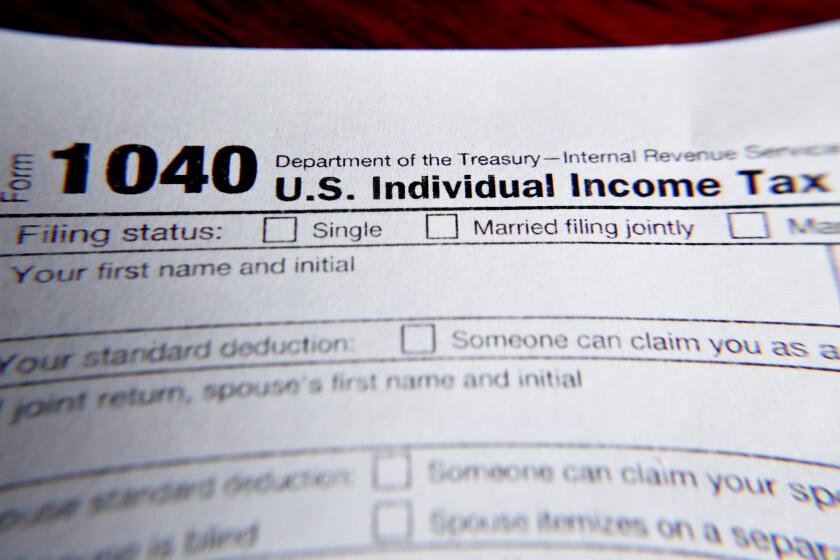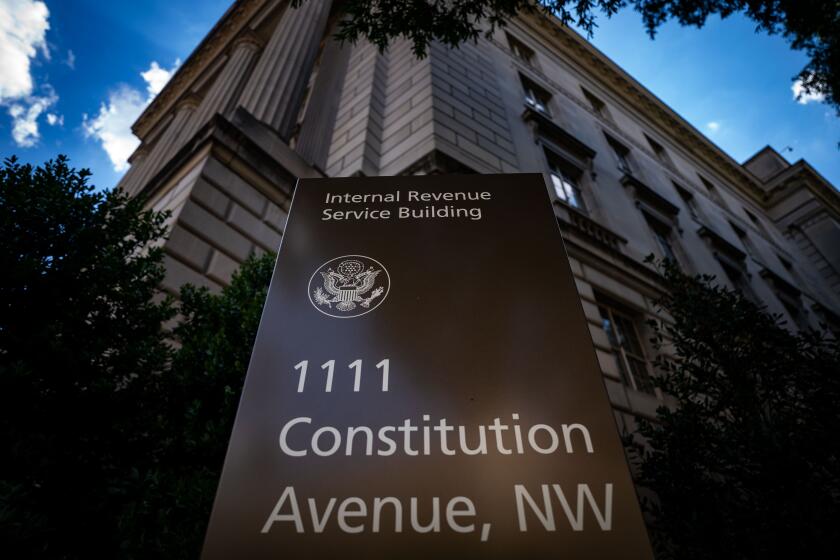Newsom, IRS give Californians until October to file tax returns

- Share via
Good news for most Californians who owe taxes to the federal or state government: The deadline for filing your return and paying what you owe has been pushed back to October.
For the record:
8:42 a.m. March 6, 2023An earlier version of this article reported that the new tax deadlines applied to the 44 counties covered by a federal emergency declaration. The deadlines also apply to the counties covered by a federal disaster declaration, bringing the total to 51. It also incorrectly reported that businesses’ payroll and excise tax payments would not be due until October. Those taxes are not included in the new deadlines.
The relief is available to anyone living or working in 51 counties covered by Federal Emergency Management Agency emergency and disaster declarations. That includes Los Angeles, Orange, Riverside, San Bernardino, Ventura and San Diego counties. FEMA’s declarations — 3591-EM and 4683-DR, which apply to different but overlapping groups of counties — came in response to the severe winter storms that caused floods, landslides and mudslides between Dec. 27 and Jan. 31.
State and federal authorities had previously delayed the deadline to May 15. Last week, though, the Internal Revenue Service pushed it back again, to Oct. 16. Gov. Gavin Newsom announced Thursday that the state is doing the same.
The relief will be offered automatically to anyone whose address on file at the IRS is in a disaster area — no need to ask for help or alert the agency that you’ll be filing late. If the IRS sends you a penalty notice anyway because you missed a deadline that should have been waived, the agency advises you to call the number on the notice to have the penalty erased.
Many software options will let you file your taxes and get your tax refund for free. And for most Californians, the tax deadline has been moved to Oct. 16, 2023, to file federal and state.
The delay to mid-October applies to every 2022-related action that would have faced an April 17 deadline, including making tax-favored contributions to an IRA or a health savings account. That gives Californians more time to gather the funds needed to maximize these deductions.
Even better for businesses and other filers who pay estimated or interim taxes or pass-through entity elective taxes — all such payments due before October have been postponed as well. You can make them when you file your annual return on or before Oct. 16.
No such extension is available for payroll or excise taxes, said Wayne R. McDonald, a longtime tax professional. “Disaster relief generally does not cover these types of tax payments other than as provided in an IRS news release with respect to a disaster.” McDonald said in an email. In the case of the two FEMA declarations in January, he said, the IRS pushed the deadline back by just a few days.
Granted, if you are due a refund, you want to file as soon as you can. Otherwise, you’re giving the government an interest-free loan.
If you live outside the designated disaster area, the IRS says you can still qualify for the delayed deadlines if you meet any of three conditions: Records you need to complete your return are inside the area (for example, if you’re a shareholder in an S corporation inside the affected area); your tax preparer is inside the disaster area and unable to complete the work on time; or you are helping the government or a recognized charity with relief efforts in the area. But you’ll need to let the IRS know by calling (866) 562-5227.
In guidance late Friday afternoon, the IRS said California’s Middle Class Tax Refund and similar payments in other states would not be subject to federal taxes.
One other point: If you suffer disaster-related losses that aren’t reimbursed or insured, you can write them off on your tax return for either 2022 or 2023, the IRS says. “Be sure to write the FEMA declaration number — [EM-3591] — on any return claiming a loss,” the agency advised. IRS Publication 547 can guide you through the requirements.
For more information, consult the Disaster Assistance and Emergency Relief for Individuals and Businesses page on the IRS site and the IRS Instructions for Form 4684.
You can deduct your disaster-related losses from your state return, too; see Franchise Tax Board Publication 1034 for more guidance. Write the name of the disaster in blue or black ink at the top of your return, or, if filing electronically, follow the instructions in the software for entering the disaster information.
As with the IRS, if you receive a late filing notice after taking advantage of the new deadline, the governor’s office said, you should call the phone number on the notice and ask that the penalty be waived.
L.A. County Assessor Jeff Prang has also said that storm damage of more than $10,000 could qualify you for a reassessment that lowers your property taxes.
About The Times Utility Journalism Team
This article is from The Times’ Utility Journalism Team. Our mission is to be essential to the lives of Southern Californians by publishing information that solves problems, answers questions and helps with decision making. We serve audiences in and around Los Angeles — including current Times subscribers and diverse communities that haven’t historically had their needs met by our coverage.
How can we be useful to you and your community? Email utility (at) latimes.com or one of our journalists: Jon Healey, Ada Tseng, Jessica Roy and Karen Garcia.
More to Read
Totally Worth It
Be your money's boss! Learn how to make a budget and take control of your finances with this eight-week newsletter course.
You may occasionally receive promotional content from the Los Angeles Times.












